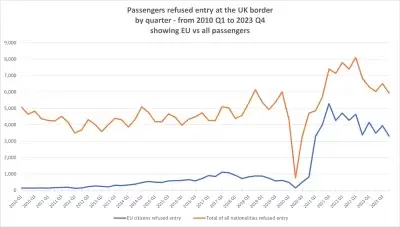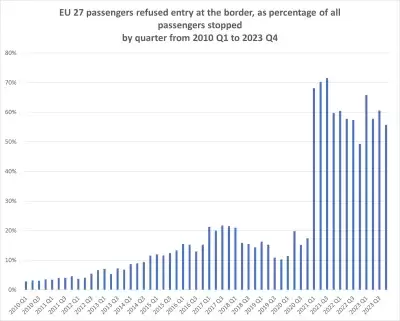EU Settlement Scheme Statistics
Every quarter, we break down the Home Office’s statistics on the EU Settlement Scheme together with data available through Freedom of Information requests and trusted sources.
This analysis is compiled and updated quarterly by University of Exeter and the3million.
- How many EU citizens are there in the UK?
-
At 30th December 2023, the EU Settlement Scheme had received 7.7 million (7,723,880) applications out of which 7.6 million (7,602,060) were concluded.
These estimates are for applications, not applicants and include repeat applications from the same person. The Home Office estimates that 6.2 million individuals have applied to the scheme, made up of 5.7 million (5,683,900) EU27 citizens, 63,100 EEA EFTA and Swiss citizens, and 495,600 non-EEA nationals.
Out of these, approximately 5.7 million individuals have received a grant of status (3.73 million holding settled, and 1.96 million holding pre-settled status as at 30 December 2023).
The Census 2021 found that 3.6 million citizens resident in the England and Wales were born in the European Union, an equivalent of 36.4% of all non-UK born residents.
The significant discrepancy in data comes from the fact the scheme opened in 2019 and there is an unknown number of people who no longer live in the UK.
Source: Quarterly Statistics, December 2023 and Census 2021
- What immigration status do people hold?
-
Out of the 7.6m applications concluded:
49% - 3.7 m were granted settled status - indefinite leave to remain
37% - 2.8 m were granted pre-settled status - limited leave to remain
14% had other outcomes (666,470 refused; 189,080 withdrawn or void; 198,750 invalid)
The number of pre-settled status holders is fairly steady at 2 million. Pre-settled status holders are converting to settled status at a rate of around 23,000 per month, while around 4-5,000 first time pre-settled status grants are made each month to joining family members.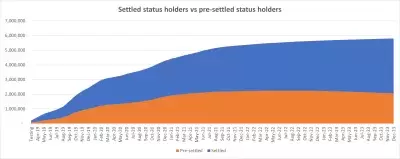
Over 74,000 applications were unsuccessful in the quarter October - December 2023. Over 40% of each month's applications in this quarter did not result in a grant of pre-settled or settled status.
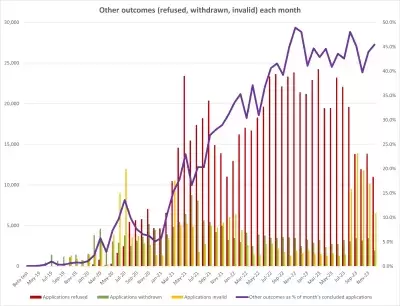
- How many people are waiting for a decision?
-
The backlog of applications stands at 121,820 at 31 December 2023. At the current rate the Home Office is processing applications, it would still take another 17 months to clear this huge and persistent backlog.
Behind every application, there is a person being left in limbo for months on end, having no security about their future in the UK.
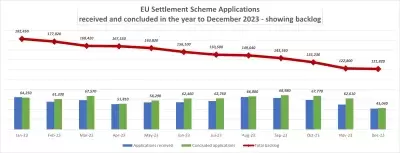
- How long have people been waiting in the EU Settlement Scheme backlog?
-
The Home Office does not publish data on processing times or waiting times, so what we know has been obtained through Freedom of Information requests. The make-up of the backlog has changed over time, as the following graphs show, with an increasing number of people finding themselves stuck in the backlog.
By 30th September 2023, our latest FOI, more than 11,000 individuals had been waiting for over 2 years for their decision. More than 19,000 people had been waiting longer than a year, more than 30,000 longer than six months.
We are waiting for responses to FOIs for more current data.
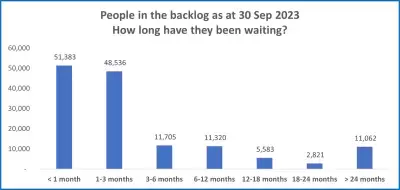
The number of cases pending for over 24 months is only now starting to come down.
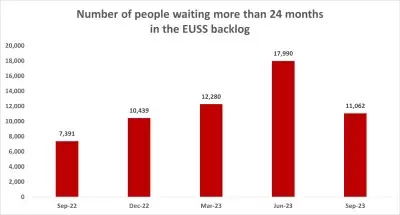
- Who is waiting in the EU Settlement Scheme backlog?
-
People waiting in the EU Settlement Scheme backlog fall into the following categories:
Late applications: Although the deadline to apply was 30th June 2021, the Home Office accepts late applications from EU citizens who were resident in the UK before 31st Dec 2020. Since the June 2021 deadline, there have been 209,800 grants of (pre-)settled status under the scheme following a late application, showing a high number of people who have rights under the Withdrawal Agreement would have become undocumented without the significant concession of allowing late applications.
This is on average 7,000 successful late applications per month. Even in the most recent quarter, October to December 2023, there were over 13,000 grants of (pre-)settled status to late applicants.
Note, in August 2023, a very significant change has been made to how late applications are processed, it is strongly recommended to seek legal advice when making a late application. See this FAQ for more information.
The effect of this change (which came into operation part way through 2023-Q3) is starkly visible in the chart below - as far more applications are now rejected than refused. A rejection does not come with a right of appeal, and it also does not come with a Certificate of Application. We recommend people obtain legal advice if they are making a late application or have received a rejection.
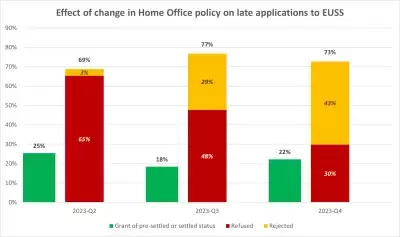
Pre-deadline backlog: People who applied in time who are still waiting. There are still 14,770 people who applied in time and have yet to receive a decision. This does not even include those who received a refusal and are awaiting the outcome of an Administrative Review or appeal process.Repeat applications: Pre-settled status holders can apply for settled status to have their permanent residence rights confirmed. This second application can be more difficult and complex, as EU citizens have to submit evidence of their 5 year continuous residency. However, see this important news release about the High Court judgment ruling that loss of pre-settled status for not making a further application is unlawful.
Joining family members: EU citizens who lived in the UK before 31st Dec 2020 have rights to family reunion. Their eligible family members apply and gain status through the EU Settlement Scheme. Note, in the October - December 2023 statistics it looks like there was a significant fall in applications from joining family members - the Home Office has said these figures may be revised in future statistical releases.
Derivative rights: In most cases, for adult carers whose rights are linked to the rights of residence of a British or EU national child.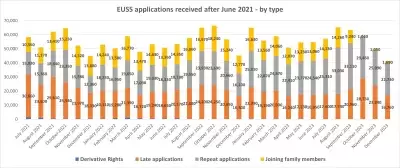
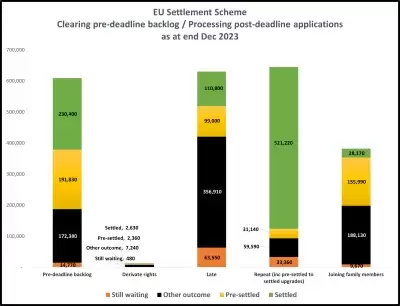
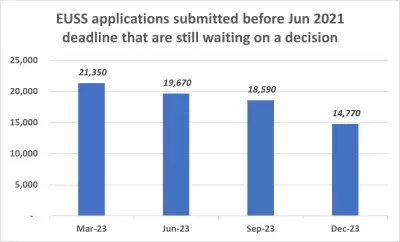
- How long does it take to receive an EUSS decision?
-
The website entitled EU Settlement Scheme: current estimated processing times for applications states “It may take up to a month for complete applications to be processed, if no further information is required, but you may receive a decision more quickly.”
Since the opening of the scheme, as at the end of March 2023, 44% of people waited for longer than 30 days before getting their status. Almost 425,000 people had to wait for longer than 6 months, and almost 65,000 people had to wait for more than a year.
The number of people whose applications took more than 18 months to conclude went up by a staggering 68% from just over 7,000 as at December 2022, to almost 12,000 as at March 2023.
We are waiting for responses to FOIs for more current data.
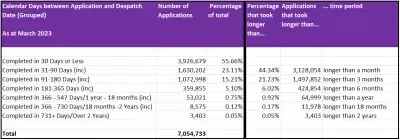
- How many family members are applying for visas to join EU citizens in the UK?
-
Family members of EU citizens can either apply for a Family Permit before they come to the UK, and then submit an application to the EU Settlement Scheme once they are in the UK; OR they can apply to the EU Settlement Scheme from abroad, if they are eligible to do so.
In the last quarter, 59% of decisions made resulted in a refusal. There had been a temporary dip to 49% in the previous quarter, but the latest quarter is in line with refusal rates since 2022..
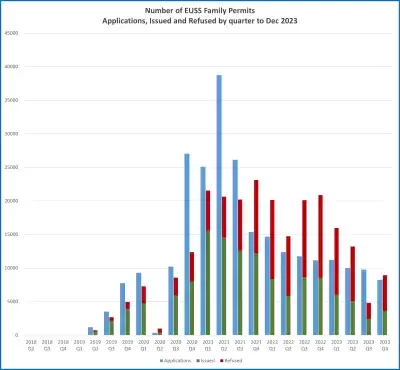
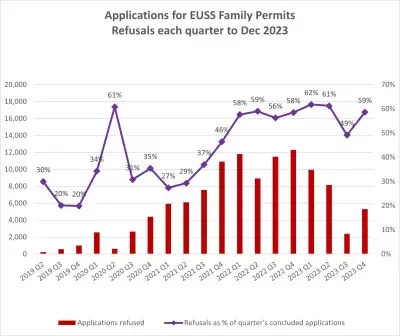
- How long does it take for EUSS Family Permits to be issued?
-
Despite application numbers remaining relatively steady since September 2021, the rate at which Family Permits are issued has been declining. Families are split apart for months on end, without any expectation management. Family Permits are the only visas which the Home Office does not set an expected time frame to be issued, and instead say they will be processed “as soon as possible”.
The average processing time reduced slightly to just over 5 months in May 23, but has been between 7 and 10 months since.
People who received Family Permits in December 2023 had been waiting for an average of 7 months. This type of entry visa is valid for 6 months, during which people can travel to the UK.
There is a queue of over 10,000 people waiting for a Family Permit. Once they are in the UK, they need to put in an application to the EU Settlement Scheme, joining their second queue.
This often leads to people being uncertain of their immigration status for extended periods of time, facing hostile employers, landlords and banks, and having difficulties travelling.
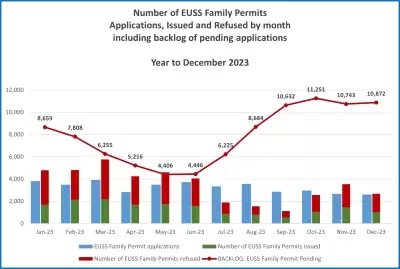
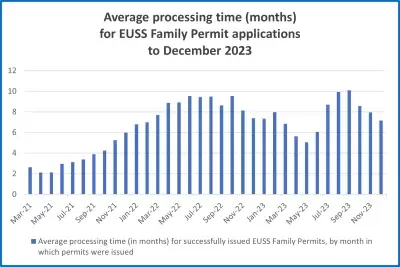
- How many EU citizens were refused entry at the UK border?
-
The statistics show an enormous increase in number of EU citizens refused entry at the UK border, which is very concerning. It shows the Home Office continues to subject people to a hostile environment where the burden of proof is always on the individual to prove their rights. After Brexit, EU citizens are now also treated with suspicion.
This is a consequence of removing free movement between the UK and the EU - it’s the same treatment non-EU citizens have always been receiving. Although EU citizens can come to the UK for 6 months as visitors, people who intend to live and work here are questioned at the border and must be able to prove their immigration status.
Whereas before COVID, the number of EU citizens refused entry was generally below 1,000 per quarter, this is now typically between 3,500 and 4,000 per quarter. When looking at EU citizens refused entry as a percentage of all people refused entry, this has also strongly increased and is now around 55%-60%.
